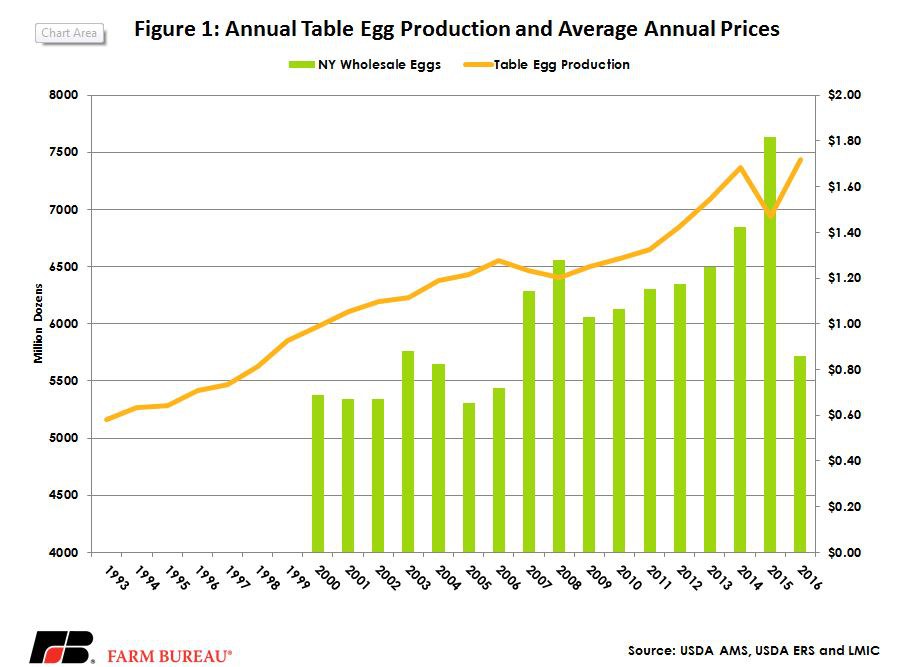Egg Prices Fall To $5/Dozen: A Market Update For Consumers

Table of Contents
Factors Contributing to the Decrease in Egg Prices
Several interconnected factors have contributed to the recent decrease in egg prices. The dramatic price increases of the past year were largely due to the devastating impact of avian flu, which decimated poultry flocks. However, the situation is improving. Increased egg production is a major driver of the price drop. This is due to:
- Increased egg-laying hen flocks: Farmers have successfully rebuilt their flocks after the avian flu outbreak, leading to a greater supply of eggs.
- Reduced impact of Avian Flu: While the threat remains, the impact of avian flu has lessened, allowing for a more stable egg production environment.
- Improved feed efficiency: Advancements in poultry farming practices and feed formulations have improved the efficiency of egg production, contributing to lower costs.
- Seasonal factors influencing egg production: Egg production naturally fluctuates throughout the year, and we're currently in a period of increased production.
Regional Variations in Egg Prices
While a $5/dozen price point is emerging in many areas, it's crucial to acknowledge that egg prices remain regionally variable. The cost of eggs isn't uniform across the country. Several factors contribute to these regional differences:
- Transportation costs from farm to store: Transporting eggs over long distances significantly impacts the final price, especially given the perishable nature of the product.
- Regional differences in egg production: Areas with higher concentrations of poultry farms generally see lower egg prices due to reduced transportation costs and increased competition.
- Local market competition: Increased competition among grocery stores in a specific region can drive prices down.
- Variations in consumer demand: Areas with higher demand may experience slightly higher prices than areas with lower demand. For example, areas with a large restaurant industry might see higher egg prices.
The Impact on Consumers and the Food Industry
The decrease in egg prices is a boon for consumers, significantly easing the burden on household budgets. This translates to:
- Increased consumer purchasing power: Families can now afford to buy more eggs, incorporating them more freely into their diets.
- Lower food costs for businesses: Bakeries, restaurants, and food manufacturers that rely heavily on eggs as ingredients will see reduced production costs, potentially leading to lower prices for consumers.
- Potential impact on related industries (e.g., egg substitute sales): With lower egg prices, the demand for egg substitutes might decrease.
- Shift in consumer buying habits: Consumers who switched to cheaper alternatives during the price spike may now revert to buying real eggs.
What to Expect in the Future: Forecasting Egg Prices
Predicting future egg price trends is challenging, but several factors will likely influence egg prices in the coming months and years:
- Potential for price increases due to feed costs: Fluctuations in grain prices, a major component of chicken feed, can directly impact egg production costs.
- Impact of future disease outbreaks: The risk of further avian flu outbreaks or other poultry diseases remains a significant concern that could disrupt egg production and increase prices.
- Long-term outlook for egg production: Sustained investment in poultry farming infrastructure and technology could lead to greater stability in egg production.
- Sustainability of the current price levels: Whether the $5/dozen price point remains sustainable depends on a complex interplay of supply, demand, and external factors.
Conclusion: Navigating the Changing Landscape of Egg Prices
The recent drop in egg prices to around $5 a dozen offers significant relief to consumers and businesses alike. This price decrease is largely attributed to increased egg production following the avian flu outbreak, improved farming practices, and seasonal factors. However, regional variations persist, and future price fluctuations remain a possibility due to factors like feed costs and potential disease outbreaks. To take advantage of the lower egg prices, consumers should compare prices at different grocery stores, look for best egg deals, and consider buying in bulk when possible. Keep an eye on egg price trends and explore cheap egg sources to maximize savings. Regularly check your local grocery stores for current prices and stay informed about market fluctuations to make the most of this period of relative affordability.

Featured Posts
-
 Luxury Car Sales In China Bmw Porsche And The Market Slowdown
May 15, 2025
Luxury Car Sales In China Bmw Porsche And The Market Slowdown
May 15, 2025 -
 Peut On S Attendre A Ce Que Lane Hutson Soit Un Defenseur Numero 1
May 15, 2025
Peut On S Attendre A Ce Que Lane Hutson Soit Un Defenseur Numero 1
May 15, 2025 -
 Ndaxs Partnership With The Nhl For Canadian Playoffs Details
May 15, 2025
Ndaxs Partnership With The Nhl For Canadian Playoffs Details
May 15, 2025 -
 Analyzing Jeremy Arndts Role In Bvg Discussions
May 15, 2025
Analyzing Jeremy Arndts Role In Bvg Discussions
May 15, 2025 -
 Discussie Bruins Npo Toezichthouder Over Leeflang Na Hamers Beschuldigingen
May 15, 2025
Discussie Bruins Npo Toezichthouder Over Leeflang Na Hamers Beschuldigingen
May 15, 2025
